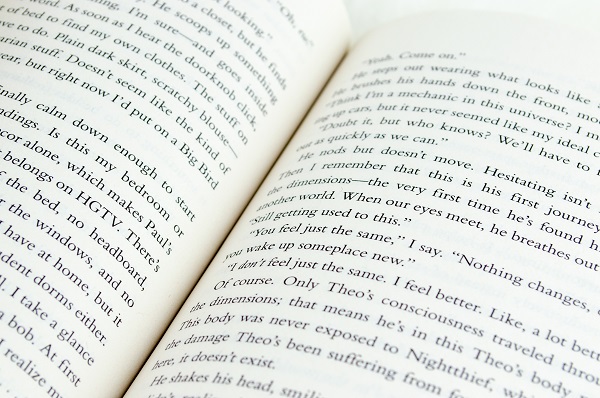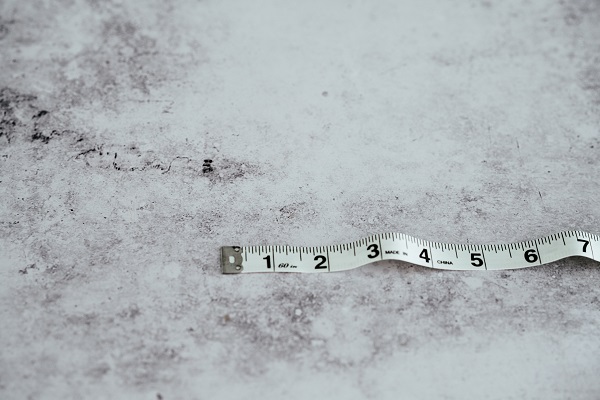Rules for writing numbers and units of measurement vary according to the style guide you follow.
However, if you’re a fiction writer, it can be easy to get mixed up with the variety of ways to write measurement in non-fiction.
I’m a rule-follower, so the idea of not knowing whether my twenty-five-year-old protagonist should, in fact, be a 25 year-old, or aged 25yrs, is like being asked to cross the road before the walk symbol has turned green.
The more you think about all the different ways a measurement might pop up in your fiction writing, the more confusing it becomes.
But avoiding making any reference to measurements at all (numbers, ages, size, length, height, distance, date, time, etc.) is likely to lead to a pretty bizarre novel.
So, unless you’re writing a postmodernist manifesto on the evils of measurement, you’re going to want to know the general rules for writing numbers in fiction. We’ve got you covered there!
(Tip: Save this article to your bookmarks and use it as a handy reference guide for writing measurement in fiction.)
Rule #1: Keep things consistent
First and foremost, consistency is key. If you maintain a consistent approach to measurement throughout your fiction writing, you’ll be more than halfway there.
This is particularly important within a sentence itself, especially if the numbers are related to each other.
Example: They needed 546 tonnes of glitter, but only had 27 tonnes.
Rule #2: Know when to spell it out and when to use a numeral
For most fiction writing, it’s recommended that numbers 0–100 are spelled out, while 101 and greater should be written as numerals.
However, some style guides and publishers prefer to only spell out numbers 0–10, and use numerals after that.
The MLA style guide specifically suggests spelling out any number that can be written in one or two words. In general, fiction preferences spelling words out over using numerals, so this is generally a good way to go.
If you’re doing this, make sure to hyphenate double digit numbers twenty-one through ninety-nine.
Now, if you’re a savvy reader, you might have noticed that I’ve already written against my own rules, and we’re only 350 words in.
Why didn’t I write ‘numbers between zero and one hundred’ or ‘numbers zero to ten’ above?
And what about that consistency clause above?
Importantly, I haven’t followed the rules here because I’m not writing fiction. I’m writing about fiction writing. Non-fiction, in all its different formats, follows different rules.
(That aside, I’m also trying to make your life easier as a reader!)

Rule #3: Focus on readability (i.e. the exception to the rules!)
In fiction writing, it is widely accepted that we should write in a way that is easy to digest for the reader because it doesn’t interrupt their reading pattern.
This means using some common sense, and breaking the rules if they lead to confusing or unwieldy writing.
Based on ‘the vibe of it’, we might decide that it looks better to write $58.50 rather than fifty-eight dollars and fifty cents in a long passage with many numbers.
We know that we’re likely to use numerals for a telephone number, and that street addresses look weird when you spell them out, except maybe when a character is speaking.
Two consecutive numbers can also look confusing, so spell one of the numbers, and use a numeral for the other.
Incorrect Example: The kitty mastermind had created sixty-two fifty-millimetre-long robot mice.
This sentence looks strange and has a lower readability level than either of these preferable sentences:
Correct examples:
The kitty mastermind had created 62 fifty-millimetre-long robot mice.
The kitty mastermind had created sixty-two 50-millimetre-long robot mice.
Rule #4: Don’t begin a sentence with a numeral
If a sentence begins with a number, you should spell it out, no matter how large or small it is. If that looks odd, try rephrasing the sentence altogether.
Example: One hundred and sixty-six thousand, five hundred and ninety-seven grains of sand were on that beach; I counted every single one.
This looks a little unwieldy, so instead try:
Preferred example: I counted every single grain of sand on that beach; 166,597 in total.
Having said that – in this case, I’d argue that it might be effective to spell the number out entirely, to reflect how long and cumbersome this poor character’s experience has been!
Rule #5: Spell out round numbers
You should generally spell out round numbers, even if they’re above the 101 threshold. Generally, eighty thousand looks better than 80,000 in fiction writing.
It has greater readability, and follows the handy ‘can be written out in one or two words’ rule.
Example: Of the two hundred thousand spectators at the match, only three thousand or so were from the Lost Moons of Mercury.
On the other hand, a large, precise number like 83,492 would be too unwieldy spelled out, so in that case, use numerals.
A comma should be used for every third digit from the right for precise numbers of four digits or more, with no spaces on either side.
Rule #6: Change it up for ordinal numbers
Ordinal numbers should be spelled out up to one hundredth, then numerals thereafter, except for round numbers as above. You should also use regular-sized type instead of superscript.
Example: Delilah the Tortoise came first in the race, but Henry the Hare came 157th. It was the three thousandth race they’d run together.
Arguably, you could spell, or use numerals for, both the ordinals in that first sentence, if you were applying the readability rule. Here, however, I believe it doesn’t disrupt the flow of the sentence.
The ordinals rule also applies for street names and military units, remembering that ordinal numbers are often used to show relationship and rank.
Examples: Seventh Avenue; 122nd Street; Fifty-sixth Battalion; 101st Airborne Division

Rule #7: Use numerals for decimals
Decimals usually indicate that specificity is important, so use numerals.
Even if the number is below ten or one hundred (depending on which style you’re going with), it should be written as a numeral in narration.
Examples: o.o9 centimetres; 4.6 percent.
Rule #8: Follow above rules for large numbers
Treat numbers in the millions and billions as you would any other number, using the rules already outlined.
Examples:
Around sixty-five million years ago, a change in Earth’s atmosphere wiped out the dinosaurs.
There are about 7.8 billion people living on Earth now. Exactly 7,818,121,083 when I last checked, but it’s going up by the second.
Rule #9: Spell out fractions if possible
Spell out simple fractions. Optionally, you can use numerals for mixed fractions, though as you’ve probably realised by now, the preference in fiction writing is usually to spell it out if in doubt.
When spelling out fractions, make sure to hyphenate them.
Examples:
She needs a two-thirds majority to win.
He needs four and three-quarters of a cup of sugar to make the cupcakes.
Rule #10: Use regional format for dates
Depending on what part of the world you’re in, the format of a date will vary. For instance, in Australia, we use UK English and format the date by day, month, then year.
Texts that use American English format differently: month, day, year. In many Asian countries, the format is year, month, day.
Whichever format you’re using, years should be written in numerals, except when they’re used to begin a sentence, at which point Rule #4 applies.
Examples:
In 1962, my grandmother was finally granted the right to vote in federal elections.
Two thousand and twenty was the year in which this post was written.
Note that the use of ‘and’ after ‘thousand’ in the second example is British English, whereas American English would leave it out.
You can either use cardinal numbers when writing the day of the month, or spell it out. Always spell out the month, and use a comma before the year for American English, leaving out commas for British English.
Incorrect Examples:
25th October, 1989
4/7/1991
4.7.91
The second and third incorrect examples make it tricky to determine which is the day or year for worldwide readers.
In the third example, it’s not even clear (though you would assume from context if it were in a longer piece of writing) whether it’s the nineteenth or twentieth century.
And if you really want to include an ordinal number like in the first example, you need to add the word ‘of’. Here are a variety of correct ways to express the date.
Examples:
Her birthday was 25 October 1989. (British English)
Her birthday was October 25, 1989. (American English)
Twenty-fifth of October 1989 was her birthday.
She was born on the 25th of October 1989.
If you’d like to add in the day of the week, make sure to use a comma afterwards for readability.
Example: Tuesday, 13 October 2020.

Rule #11: Ditch apostrophes for decades and centuries
Decades and centuries don’t need apostrophes before the plural, as they’re not possessives. 1960s, 1900s and 60s are correct, not 1960’s, 1900’s or 60’s (though ’60s would be fine, as it’s an abbreviation).
Regardless, decades and centuries are usually spelled out in fiction, unless referring to a specific year, as with the dates rule above.
Example: I was born in the nineties, and my mother was born in the sixties; 1967 to be precise. It’s the twenty-first century now, anyway.
Notice that you don’t need to capitalise twenty-first century – this would be incorrect.
For AD and BC, AD comes before the figures, and BC after. If possible, the letters AD and BC should be set in small capitals.
Examples: AD 439; 295 BC.
Rule #12: Be consistent with time
When writing about time, use numerals with an exact time, or with a.m. or p.m., but spell numbers out with ‘o’clock’.
Between the hour and minutes you can use a full stop/period or a colon, but make sure to pick one and maintain consistency.
Examples:
The meeting began at exactly 11.10 a.m., but I thought it would be best to be seated no later than eleven o’clock.
We arrived just before four o’clock. The spaceship landed at exactly 4:38 p.m.
Be sure to use lowercase, not uppercase, for a.m. and p.m. Include a space between the numbers and a.m. or p.m., but don’t include a space within a.m. or p.m.
Incorrect Example: We arrived at 3.45P. M..
Don’t use a full stop/period at the end of a sentence that uses a.m. or p.m. Some style guides do away with this problem by omitting the full stops or periods, and just using ‘am’ or ‘pm’.
Examples:
We arrived at 3.45 p.m.
We arrived at 3.45 pm.
We arrived at 3:45 p.m.
We arrived at 3:45 pm.
When time is expressed in hours and minutes, use a hyphen between them, unless the minutes themselves must be hyphenated.
Example: Was it two-thirty, or two forty-five?
Hours, minutes, seconds and all similar words should be written out rather than abbreviated.
Rule #13: Follow above rules for height/length/weight/age and other measurements
You can correctly write a character’s height a number of ways, particularly when it comes to imperial measurements, but remember to pick one way and be consistent.
Follow the general rules for numbers already outlined when deciding between spelling out a number versus using a numeral.
Example (Metric):
She was 205 centimetres tall.
A 205-centimetre-tall woman.
Examples (Imperial):
She was six feet nine inches tall.
She was six feet nine.
She was six foot nine.
She was six nine.
A six-foot-nine woman.
You’ll see that hyphens are used only when the height is expressed as an attributive adjective (before the noun) rather than a predicative adjective (after the noun).
This same rule applies to other measurements like distance, size, weight and age.
Examples:
A twenty-five-year-old woman.
He was aged forty-five.
They were thirteen years of age.
The puppies were only eight months old.
The 4,300-hectare farm.
The sun is 149.26 million kilometres away.
After carrying my little brother around for two weeks, I genuinely started to believe he weighed five hundred pounds.
Also note that you should write words related to measurement in full, rather than using abbreviations: pounds, years, ounces, metres, millimetres, feet, inches, kilometres, yards, etc.

Rule #14: Follow above rules for money
Money can follow the rules for numbers generally.
Examples:
Never in a million years would I buy a handbag for more than fifty bucks.
I tried not to have a heart attack when I looked at the tab and realised they’d spent $1439 on drinks.
A six-euro bus fare didn’t seem too bad to me.
Don’t use unnecessary extra hyphens, other than where you should usually use them – including in reference to an actual bill or coin, as per the rule above.
Examples: twenty-two euros; twenty-dollar bill; five-yen coin.
Rule #15: Replace symbols with words where possible
Symbols such as $ or % or ° should be replaced with words in dialogue, and in narrative where it doesn’t disrupt the flow of reading.
Generally you should spell out percent/per cent, but using a numeral alongside the words is okay in order to follow the general rules for numbers.
Examples:
It was estimated that 117 percent of the puppies were aliens.
It was thirty-eight degrees outside, and air-conditioning cost over two hundred dollars a month.
Rule #16: Replicate technical words and brands precisely
Stick to how a brand name would ordinarily be spelled, even if it contains numbers you would usually write in full. Use the styling on the brand or company’s official materials as a guide.
Examples: 7-Eleven; Forever 21; WD-40; Chanel N°5
Similarly, for technical words (e.g. weaponry, as commonly found in action/thriller fiction), stick to commonly used numerals, unless it is being pronounced in a very particular way in dialogue.
Write technical words as the manufacturer would, including capital letters, and spell out the word calibre (or caliber, for those using American English). Millimetres can be abbreviated in this case.
Examples: AK-47; Browning 9mm
Rule #17: Spell out numbers in dialogue
In dialogue, you should spell out numbers as a general rule, because it helps readers to hear how it sounds coming from that character’s mouth.
It’s also not as important to stick to convention here; rather, you should make sure that the character sounds like themselves.
Example: ‘You owe me a hundred and five bucks, ’cause I’m chargin’ ya three-and-a-half percent interest, mate.’
This suits your stingy dad character, and reads better than ‘You owe me $105 because I’m charging you 3.5 percent interest, mate.’
An exception is that you can use numerals for four-digit years, unless your character has a unique pronunciation. You’ll see here it certainly adds more nuance to the character when spelling things out.
Examples:
‘My great grandfather, born 1908, lived through two world wars.’
‘Great granddaddy? Born nineteen-oh-eight, he was.’
‘Whaddaya mean, what year is it? Two thousand three, obviously.’
‘Seriously? You’ve forgotten the year? It’s 2003.’
‘Good gosh, old chap, it’s two thousand and three, don’t you know.’
For longer numbers like telephone numbers, you’ll likely want to use numerals if they need to appear in dialogue for some important reason.
Use your best judgement as to what will make for easy reading without taking away from the quirks of your character.

Rule #18: Roman numerals are fine (except in dialogue)
Roman numerals can be used in personal names like King Henry VIII, except in dialogue, which should follow the rules above.
Examples:
King Henry VIII. There he was, in all his smarmy glory. What a jerk.
‘Oi, Henry the Eighth! Grow up!’
Style guides for reference
While this list explains common rules for fiction writing, sometimes it might be useful to consult broader style guides or editorial handbooks.
However, don’t forget that they are often designed for academic writing rather than fiction, and also that publishers will have in-house style guides that they prefer.
- Chicago Manual of Style
- Australian Handbook for Writers and Editors
- MLA Formatting and Style Guide (Academic papers)
- Associated Press Stylebook (AP Style) (Newspaper and magazine-style writing)
- APA (American Psychological Association) (Scholarly writing first and foremost)
Consistency + readability = success
These rules are great for reference, but you need to remember that it’s okay to break a style rule if it’s interrupting readability.
You’ll find that the old adage, ‘Learn the rules so you can break them’, will often apply.
Make an informed choice, but be open to change. If you’re really stuck on a confusing sentence or paragraph that just doesn’t look right, you can also consider rearranging to avoid any eyesores.
Example: In 2018 I shacked up with Amir. Twenty-nineteen we broke up.
Looks weird, right?
Preferred example: In 2018 I shacked up with Amir; 2019 we broke up.
Much better!
On top of these considerations, remember that each publisher will have an in-house style guide, which will be consistent and preferred across their range of fiction, and might differ from the rules above.
Copyeditors will be your best friend in this case, and will be able to guide you to suit their publishing style.
I recommend creating a style sheet as you go and sticking to it, while also considering your characters’ voices, nationalities and quirks.
If you have a first-person or close third-person frame of narration, perhaps your character’s unique voice will always take precedence over the rules, even outside of dialogue.
While a publisher will have a hand in making these decisions if you go down the traditional publishing route or engage a professional editor, it will still be much appreciated, and look more professional, if your manuscript is consistent.
That’s the takeaway message here: be consistent, and when inconsistencies are unavoidable or you face rules that conflict one another, always focus on clarity for the reader.